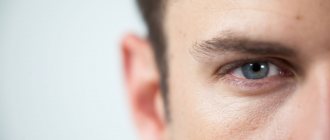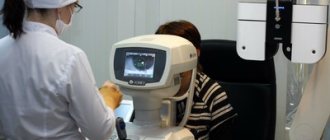Visual loads play an important role in the proper development of the children's visual system. Most parents and doctors believe that today one of the main “enemies” of the child’s psyche and vision is television and computers.
All recommendations and advice from doctors regarding this topic boil down to the fact that in infancy, television must be completely excluded from the children's diet. And from the age of three years, the computer and TV should be kept to a minimum.
In order to understand how important it is to comply with these restrictions, it is necessary to find out how the children's visual system works and how children's eyes react to TV, computers and other equipment.
While watching TV, the child's eyes perceive visual images as a light flux, which is refracted inside the eyeball and projected onto the retina. In order to clearly see the image, the child, at a subconscious level, stresses special visual structures inside the eye, which are responsible for visual acuity.
If the child’s vision is subjected to such a load regularly, the regime is not followed, the child sits for a long time in front of the TV, and the visual load does not correspond to the child’s age, as a result, the child’s visual abilities fail. As a result, the child begins to actively develop myopia.
Quite often, due to insufficient lighting in the room and the very bright backlight of the computer monitor or TV, the child’s eyes quickly get tired, and visual fatigue sets in, which is accompanied by redness of the eyes, headache or pain in the eyes.
How to find a way out of the situation?
After all of the above, you should not be too scared and completely exclude TV from your child’s life, since in the modern world a child must grow and develop, watch interesting and educational programs and cartoons, read books, play and communicate with his peers.
In order to protect children's vision, you just need to find a reasonable compromise.
All children under two years of age are categorically not recommended to watch TV, since they still do not understand anything at all from what they saw and perceive all the information as bright and colorful pictures.
And all this is not only directly related to severe strain on the eyes, but also has a detrimental effect on the baby’s central nervous system, which in turn leads to overexcitation of the child.
Children over two years of age should be allowed to watch TV no more than thirty minutes a day, children from three to seven years old should be allowed to watch TV for no more than one hour, and children from seven to thirteen years old should be allowed to watch TV for one and a half to two hours a day.
The influence of television on children's vision. What to do?
We receive most of the information (up to 90%!) from the outside world visually, which is why it is so important to protect children's vision. The better condition it remains at the time of the beginning of adult, independent life, the calmer we, parents, will feel, and the more confident a child will feel.
Why are pediatricians and ophthalmologists sounding the alarm? The explanation is simple: the children's visual system is very vulnerable and susceptible to external influences. Thus, newborn children have a shortened eyeball, which leads to physiological farsightedness and goes away by 12 months. Vision is completely normalized and stabilized at 3-5 years, so up to 5 years it is important to avoid the negative influence of the external environment, one of which is television - and with every right to do so.
Why is watching TV so dangerous for a child? The images on the screen are moving, often small and unclear, so the child unconsciously strains his eyes to better distinguish and understand what is happening. If watching TV is prolonged, and mother and child forget about breaks and “television safety” techniques, then the load on children’s eyes becomes excessive, which leads to visual pathologies (the most common is myopia).
At a minimum, excessive watching of TV causes redness and pain in the child’s eyes, as well as headaches. As a maximum, in addition to the strain on vision, you can add a negative impact on the psyche (including self-esteem and worldview), harm to posture (if the child does not watch it during a TV session) and to digestion (if the baby gets used to watching TV while eating).
We live in the 21st century and we cannot completely ban TV for children. We feel our helplessness so acutely that we have even come up with punishments - “a day without a tablet” or “a week without TV”, but we can still try to reduce the harm from it. After all, cartoons and children's programs help us understand the world, promote socialization and shape our worldview.
It is important to follow simple rules.
1. Limit your viewing time
It is not advisable for children under 2 years old to watch TV at all - not only because of the strain on the eyes, but also because of the risk of overstimulation of the central nervous system (advertising is especially harmful). As a last resort, children's ophthalmologists allow children to watch cartoons and children's programs for 15 minutes a day. The maximum time in front of the TV for children 2-3 years old is 30 minutes a day, for children 3-7 years old - 40-50 minutes a day. A child 7-13 years old can already be allowed to watch TV for up to 2 hours a day (but make sure that continuous viewing is no more than an hour and a half).
2. Monitor the position of the child’s body: you should only watch TV while sitting, otherwise there will be additional (and therefore unnecessary!) strain on the eyesight. The distance to the screen must be at least 3 meters.
3. The screen size must be 21 inches or more: the larger the screen, the greater the distance to it. The picture must be of high quality - without flickering, interference, or blurriness. If the TV is acting up or the signal is unstable, then it is better to cancel the viewing.
4. In the evening, watch TV only with additional lighting on.
5. During advertising, take breaks with your child for visual exercises.
6. Develop an optimal TV viewing schedule - both from the point of view of visual load and from the point of view of benefits for the child. Be consistent - do not allow today what was prohibited yesterday.
7. Regularly visit an ophthalmologist with your child: in the absence of congenital problems and genetic risks - at least once a year.
A few simple rules for “communicating” a child with TV:
- It is necessary to watch TV only in a sitting position, and also in a place convenient for the child.
- The location of the screen also plays an important role; it should be located exactly in front of the child. The child should not be allowed to watch TV from the side, since prolonged exposure to the TV in this position over time can lead to the development of strabismus in the child.
- If a child watches TV in the evening, additional lighting is needed in the room, while during the day, due to the strong penetration of light into the room and glare on the TV screen, it is advisable to close the curtains.
- The visual distance from the child to the screen should be at least three meters, based on the diagonal of the screen being twenty-one inches. It is necessary to understand that the larger the screen, regardless of whether it is plasma or flat, the further the child must be seated from it.
- You should also remember that children under seven years of age are not recommended to spend more than an hour and a half at the computer. And older children need to rest their eyes every hour of sitting at the computer (10-15 minutes). It is also advisable when purchasing a monitor to make sure that the screen has a special coating that protects your eyes from radiation.
Causes of myopia
Myopia develops for several reasons. The first is a failure to form and lay the eyeball in utero: infections during pregnancy, premature birth, etc.
The second reason for myopia is heredity. If parents (or even just one grandmother) are myopic, the likelihood of developing eye pathology in the child is quite high.
But even if no relative in the family has an eye disease, the risk of developing myopia remains. Acquired myopia is a disease of technological progress, a consequence of excessive visual stress, which increases every year among modern schoolchildren, and children’s uncontrolled fascination with gadgets.
Do you experience discomfort, tension, fatigue after a working day spent in front of the monitor? The same symptoms are typical for children. But unlike adults, such stress affects children much more seriously and can cause a sharp decrease in vision.
By the way, about the dangers of TV. TV causes more harm to a child’s nervous system than to the eyes, since when watching TV, the eyes focus at a fairly far distance. Provided that the TV is no closer than 2.5 meters from the eyes.
Two problems
Children who “live” on a screen face two problems. The first is true or false myopia (myopia). With true myopia, the eyeball is slightly elongated. In the second case, a spasm of the eye muscles occurs, and they cannot adjust the sharpness of the image in time.
The second problem is dry eye syndrome, which develops due to the fact that, enthusiastically staring at the screen, the child forgets to blink. Normally, we lower our eyelids 18 times per minute, constantly lubricating the cornea with tear film. But looking at the screen, we do this only 2-3 times per minute!
Electronic educational program will help us avoid both eye problems.
News
09.08.2018
Dear patients! For two years now, our center has introduced the method of refractive therapy with night lenses from the American company Paragon. In general, these lenses have been used since 2002 and have proven themselves in 55 countries around the world. For my part, I can note the high effectiveness of night lenses in children with progressive myopia. This is myopia inhibition and 100% vision all day long without glasses or soft lenses.
Why did we start working with Paragon lenses, having already had experience using other night lenses? They are attracted by the high gas permeability of the material, the improved design and the lightness of the lenses. They are 30% thinner and lighter than all other orthokeratology lenses. The lens weight is only 0.9 g, and the lens thickness is 0.2 mm! All these indicators make their use effective and safe at night.
I recently read the article “Development of myopia in children and its control” on the Paragon company website. The article presents chapters from the book by ophthalmologist Nicholas Despotidis. In the photo next to him, I recognized my teacher in refractive therapy, Oksana Sergeevna Averyanova, who recently returned from the conference of the American Academy of Orthokeratology - 2021, where this photo was taken. I advise everyone to read this article. In it you will find a lot of interesting and useful information. Sincerely, Smirnova I.Yu.
In 2050, every second person will have myopia. Our children suffer from it, and there is no solution to this yet.
When I first started working as an ophthalmologist, about a quarter of children in the States had myopes. However, it seemed as if every year I was prescribing more and more glasses specifically for children with myopia.
In my previous book, Children Are Myopes Too, I looked at how lifestyle influences quality of life, citing common questions:
· “Does TV spoil children’s eyesight?”
· “Does poor lighting spoil reading?”,
· “Does posture affect vision?”
· “Can video games affect the quality of vision?”
I have no doubt: all of the above factors affect children's vision, and my book demonstrates research on environmental factors that have an effect on young vision.
Myopia is spreading at an alarming rate: comparative studies have shown a 66% increase in the incidence of myopia from 1971 to 2004 in the United States. In East Asia, the picture is even worse: in some regions of China and Taiwan, myopia increased by 90% during the same time. In Korea, almost 96% of schoolchildren wear glasses. The World Health Organization considers myopia among children to be a pandemic.
Children today spend less time outdoors, especially in countries where computers, smartphones, televisions and air conditioning are more accessible. Could a simple lack of sunlight be the cause of these trends in vision deterioration?
My clinical intuition tells me that several factors play a role in this: heredity, time spent indoors, and also activities that require focusing vision over short distances.
“It’s stuffy outside!”
"It's frosty outside!"
“No one is walking outside, so I’ll stay at home.”
Today, children don't have to go outside when they want to have fun. Moreover, they will spend their leisure time at home with great pleasure.
A hereditary factor is involved in the development of myopia.
According to statistics, if one parent wears distance glasses, the likelihood that the child will need such glasses is 20%. If both parents – the probability is more than 40%.
In my clinic, more and more children need glasses to correct myopia. It is a fact.
But it's more than just an inconvenience: myopia can lead to a number of serious consequences.
The stronger it is, the greater the length of the eye becomes. As the eye lengthens, its inner layer, the retina, stretches, which can lead to a number of complications:
· retinal disinsertion,
· glaucoma,
· macular degeneration,
· cataract.
Glasses, contact lenses, laser correction can improve the quality of vision, but do not solve the concomitant conditions of the retina and related complications!!
This is especially true now because it is predicted that more than one billion people will suffer from high myopia!
Today in East Asia, one in five teenagers is severely nearsighted. Half of them may lose their vision irreversibly with age.
At this rate, by 2050 the incidence of severe vision loss due to complications associated with myopia will increase sevenfold!!
“A little precaution is worth more than a myriad of treatments.”
I remember how many years ago I, chained to a chair, listened to the report of a famous scientist. He warned that as the incidence of high myopia increases, so do the risks of conditions that can lead to vision loss.
The hall was then stupefied.
After all, we viewed myopia as an inconvenience that could be corrected with glasses or contact lenses, but not at all as a potential cause of blindness.
Until then, I had not associated the increase in myopia with the increasing number of cases of serious eye problems.
More children wearing glasses means more adults at risk of blindness. This realization scared me greatly.
However, the severity of my impressions subsided in the whirlpool of daily work when I returned to my office.
But a few years later, at another symposium, the main speaker again raised the issue of complications of high myopia. It so happened that a few weeks after this report, the speaker, who was himself nearsighted, suffered from a detached retina.
We, ophthalmologists, often think that we are invulnerable to the diseases we treat.
Unfortunately no.
Three conclusions:
1. the best way to prevent vision loss due to myopia is to prevent the development of myopia;
2. at the first visual impairment, consult a doctor;
3. An annual ophthalmological examination not only promotes good vision, but also ensures eye health.
Myopia does not give any concessions.
Some facts you should know about myopia
· When both parents are nearsighted and the child spends less than five hours a week outdoors, the risk of developing myopia by the age of fourteen is 60%. If a child spends 14 hours a week on the street, the risk drops to 20%. And for each next hour the risk decreases by 2%. Thus, staying outdoors can completely eliminate a hereditary predisposition to myopia.
· It is not yet completely clear how sunlight can prevent the development of myopia. But there are many theories. The most popular theory suggests that the wavelengths emitted by the sun stimulate the release of dopamine in the eyes, which inhibits eye growth and thereby delays the development of myopia. In addition, bright light causes the pupil to constrict, which in turn reduces the blurriness of the picture. The less often the eye sees blurry pictures, the slower myopia develops.
Rice. 1. It has been discovered that the characteristics of sunlight help against the development of myopia. Daylight emits equally strong radiation from all waves of the electromagnetic spectrum. Artificial radiation is not as strong and has a smaller wavelength range
How to properly treat myopia?
Of the many methods, three are the most effective:
1. Orthokeratology – night lenses in which the child sleeps and removes during the day.
2. Multifocal contact lenses, worn during the day and removed at night.
3. Atropine eye drops at night. (For now prohibited for use in Russia)
The most important problem is to convince doctors and parents to abandon the traditional idea of not correcting a small degree of myopia or not completely correcting it!
How much sleep do you need? According to the National Sleep Foundation, it is advisable to get 8-10 hours of sleep, which is simply not feasible for most teenagers.
Lack of sleep has many consequences, including:
· unable to concentrate,
· overwork,
· depression.
Unfortunately, in my practice there are a lot of children with lack of sleep.
I constantly have to prove the need for healthy sleep, and often it feels like I'm talking to the wall.
“Research clearly shows that getting enough sleep for teenagers means lower risks of obesity and depression, better grades and test scores, and overall better quality of life,” says Judith Owens, MPH.
Sleep is critical for the brain to restore its resources. During sleep, harmful brain metabolites are eliminated and brain cells are repaired, providing the ability to focus and concentrate.
The feeling of sleepiness is caused by melatonin, a hormone produced in the brain. Blue light from phone and tablet screens suppresses its secretion, thereby imposing a false sense of cheerfulness. Also, intense mental activity can negatively affect melatonin production. Therefore, “I recommend that all my student patients stop using any gadgets an hour before bedtime.”
"Don't do what I do - do what I say."
The truth is that children do not follow our instructions, but our actions. When it comes to setting an example for posterity, words and actions are two very different things.
I, like you, and like any person, make mistakes... a lot of mistakes. And I try to draw conclusions from them and share them. Here are my four tips:
· Find time to part with your phone so that sometimes you don’t have the opportunity to look at it.
· No gadgets at the dinner table.
· No gadgets in the bedroom before bed.
· Avoid using your phone while working (at school, university, at your place of work).
That's all! Four feats that I always tell my patients about. If you do them, I’m sure your children will too.
Raising children with healthy vision is easy: balance everything.
Give children the opportunity and reason to spend time outside and limit the use of gadgets that cause addiction.
The myopia epidemic is a harbinger of more than just the spread of childhood myopia. This is a social problem caused by the commercial misuse of modern technologies.
Your example should work. Help your children, and they will succeed in education, so that later they will be able to earn good money and, thereby, ensure a happy life for themselves.
We - parents - must learn to believe in our children. Expect the best, demand the best, and don't praise for achievements, just help them achieve them.
Ophthalmologist, Nicholas Despotidis
Make an appointment
request a call back
View all Promotions
How to wear glasses correctly?
There is no need to be afraid of vision correction with glasses. Glasses are an element of comfort and necessity. For low myopia, glasses are prescribed only for distance vision. For constant wear, glasses are prescribed only for high myopia.
But if a child puts on glasses and does not want to take them off, it means that he is uncomfortable without glasses and has difficulty seeing. There is no need to declare war on him by forcing him to take off his glasses when he reads a book. It is better to choose bifocal glasses in which he will be able to look both into the distance (through the upper part of the glass with stronger correction) and near (through the lower part, where the minus is less, and maybe even a plus) without harm to the eyes. This division can be made invisible to others.
The main cause of myopia
So, the third reason is excessive visual stress at close range.
The human eye is originally designed for looking into the distance. When working at close range for a long time - reading, writing - the eyes experience serious strain and adapt to working at close range. The ciliary muscle, which controls the lens and helps us focus at close range, is in “habitual” tension. (This is also called a spasm of accommodation.) This spasm leads to elongation of the eyeball.
Therefore, it is extremely important to take breaks of 15 minutes every 30-40 minutes during classes. And the best thing is to alternate classes with active recreation in the fresh air. But, unfortunately, this is not always possible.
At school, parents cannot control what their beloved child does during recess, and teachers do not have such an opportunity, so the main task of adults at school and at home is to instill a sense of responsibility in the child and explain the influence of the gadget on vision.











